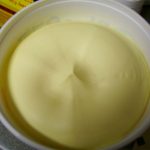 Margarine exists today thanks to Napoleon III (nephew of the more famous Napoleon Bonaparte) who offered a prize in the early 1860s to anyone who could create a butter substitute, a cattle plague having made all dairy products in France scarce and expensive. The eventual perfector of the product named it oleomargarine, from oUine, the French name for a common natural fat, and from margarique, a pearl-coloured fatty acid whose name had earlier been developed from the Greek margaron, meaning pearl. It was with this cumbersome name, oleomargarine, that the bread-spread first became known in England in the 1870s. Within a few years, however, the name butterine had also become familiar, a change effected by the margarine producers, who wanted to associate their product with real butter. In response, butter-makers succeeded in 1887 in forcing their competitors by law to change their product’s name to something that did not allude to the word butter at all: margarine.
Margarine exists today thanks to Napoleon III (nephew of the more famous Napoleon Bonaparte) who offered a prize in the early 1860s to anyone who could create a butter substitute, a cattle plague having made all dairy products in France scarce and expensive. The eventual perfector of the product named it oleomargarine, from oUine, the French name for a common natural fat, and from margarique, a pearl-coloured fatty acid whose name had earlier been developed from the Greek margaron, meaning pearl. It was with this cumbersome name, oleomargarine, that the bread-spread first became known in England in the 1870s. Within a few years, however, the name butterine had also become familiar, a change effected by the margarine producers, who wanted to associate their product with real butter. In response, butter-makers succeeded in 1887 in forcing their competitors by law to change their product’s name to something that did not allude to the word butter at all: margarine.
A product which resembles butter in consistency, colour and flavour, except that it contains no butter fat and is made from hydrogenated vegetable oils.
Butter substitute made from refined vegetable oils or a combination of vegetable oils and fats. Coloring material and vitamins A and D are added. It contains 9 kcal/g.
A non-dairy spread alternative composed of animal and/or vegetable fats, possessing a considerable proportion of water content. This product is commonly enriched with vital nutrients and tinted with the natural coloring agent, annatto, resulting in its distinct yellow hue.
Introducing a manufactured fat that initially emerged as a remarkable alternative to butter. This innovative creation traces its origins back to 1869 when it was ingeniously invented by a Frenchman named Megés Mouriés. Originally crafted from a blend of animal fats, this groundbreaking substitute paved the way for a new era in culinary possibilities. With its unique composition, this manufactured fat opened doors to culinary creativity, offering a viable option for various culinary applications. Embrace the spirit of innovation as you explore the diverse uses and benefits of this remarkable creation that revolutionized the world of fats and continues to shape modern cuisine.
